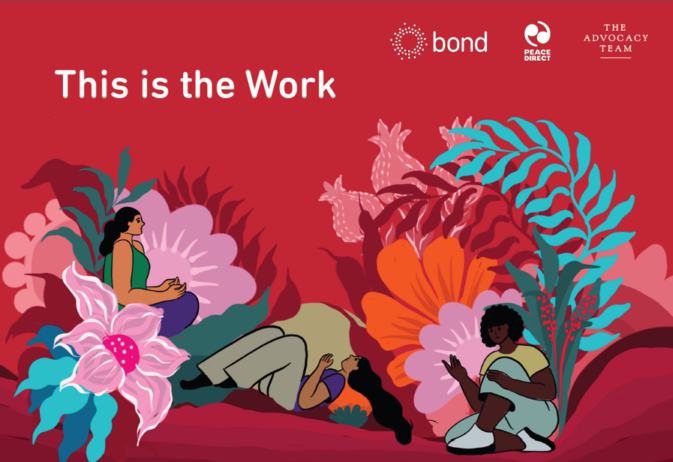Co-creation rather than participation?
Participatory practice has often been cited as an answer to the problem of how to enact equitable story production, but it is not the ‘silver bullet’ solution to this larger problem.
This is for mostly practical reasons. Firstly, it is one very specific mode of production that is best led by a trained professional who understands the ethical implications and outcomes of the process and has experience of enacting the facilitation methodologies developed and tested over decades.
It also takes a lot of time – it is difficult to enact a proper participatory process in a week, let alone a few days (I know, I’ve tried), and this can make it expensive and difficult to enact within NGO content production timeframes.
Thirdly, without being run by professionals it runs the risk of being potentially more extractive than traditional content production, as it promises power shifts, and if these are not delivered the fallout in terms of contributor expectations can be great.
This should not to put you off running participatory projects. There are many examples of powerful NGO storytelling which has been facilitated by a participatory process, including these examples, which are both successful projects that I worked on: My Own Account and How we survived. But this process is not the answer to the everyday problem of how to enact equitable story production while meeting the day to day needs of NGO communicators, fundraisers and story tellers.
Instead, I think it is more useful to think about how you co-create stories in partnership with the affected populations with whom you work. Co-creation is essentially a process of story production which places sharing power as its north star – the most important component of story production. Power in story production comes at the points of decision making – what story to tell? Who to tell it? How to tell it? What to show? How to show it? It is by answering these questions in partnership with affected populations that those of us who produce stories can change or impact the narratives of the world as understood by our audiences.
There are some key changes included in this process that might feel difficult or challenging to those with, like myself, many years of more traditional story production experience. I am regularly asked questions such as: but what if contributors don’t suggest ‘good’ stories? How can we expect someone without communications or fundraising expertise to know how to tell a story that works to engage our audiences?
These are valid questions, but the simple answer is that by working in this way you grow the sum of expertise in the decision-making process. You become a team – you bring the communications or fundraising expertise, the photographer or film maker brings their visual storytelling expertise, and the contributor (the person or people from the affected populations) brings their contextual and lived expertise. Together, you pool your expertise, experience and knowledge to become a storytelling team made up of all the elements needed to tell a compelling and authentic story.
But, how to do this? Time and resources are variable, but the determination to share narrative power does not have to be. I have developed a tiered process for co-creation, one that recognises this north star while also being pragmatic about the realities of content production.
Tier 1 // consultative co-creation
This tier recognises that sometimes you only have half a day to produce a story, and that in that timeframe you are only able to consult with the individual whose story you wish to share.
Key actions include:
- Write an ‘open brief’ before story production. This is a brief that details the core story subject matter (your WASH or vaccination program in a location for example), and information about who has been impacted and how, but does not provide a wish list of whom you want to hear the story from, nor a list of pre-defined questions to ask that person.
- Prioritise gathering one story over multiple.
- Ask who would like to share their experiences as a story for the public domain rather than casting someone. Be aware of power dynamics in the location and be specific if you wish to speak to those who may not feel empowered to put themselves forward.
- Spend 50% of the time you have with the individual contributor and/or their family explaining why you wish to share their storyand the channels on which you plan to share it (with downloaded or printed examples), and roughly who your audience are (demographics, locations, ages etc).
- Facilitate a discussion that answers these questions:
- What part of the story of what we have supported here is most important to tell?
- What should we show and not show?
- What questions do you suggest that we ask?
- Use this information to create a shot list that you share with the individual contributor for their input.
- Share finished materials back with the contributor so they can see what they helped to create.
Only then should you go ahead and produce your story materials, guided by the contributor’s inputs, but also using your own knowledge about how to tell powerful and engaging stories.
These actions facilitate the sharing of power, are part of the consent dialogue, and will enable a better story, as you will be shown what is really happening in that location, and the contributor in the process will be briefed enough to be able to guide you to share a more fully rounded and authentic story.
Tier 2 // co-lab co-creation
This tier is for when you have one or two days in a location and can collaborate with a small number of contributors in a fuller way to define the story parameters.
Key actions include:
- As with tier 1:
- Write an ‘open brief’ before story production.
- Ask who would like to share their experiences as a story for your organisation to share in the public domain rather than casting someone.
- Facilitate a discussion with guided questions.
- Share why you are sharing the story, the audience and channel information.
- Facilitate a guided discussion about what story to tell and how (this can be slightly longer as you have more time). What part of the story of what we have supported here is most important to tell? What should we show/not show? What questions do you suggest that we ask?
- Agree to pay a stipend for the contributor’s time. Inputting into your story production is labour, and if you are all being paid then so should your contributors. Be guided by a typical local wage for the individuals with whom you are working, and be sure to give a clearly outlined receipt detailing what they have been paid for and how much.
- Use this information to create a shot list that you share with the individual contributor for their input.
- Share this shot list with the contributors and aski for their inputs or changes. Suggest what you think will work and ask for their inputs on these suggestions. Create a dialogue.
- As a working team, go out and produce story materials to that shot list. Encourage a production dialogue using the shot list as a guide – are we getting what we need? Is this all working in the way that we expected it to work? What might we do differently? With all team members inputting their views.
- Review the shot list and amend if necessary.
- Agree a timeline by which you will share back materials so that contributors can see what they helped to create.
Tier 3 // contributor centred co-creation
This tier is closest to participatory storytelling, although it’s not the same thing, and requires four to five days with a group of contributors. It is a more complex process and is likely to require some external support.
Key actions include:
- Not writing as brief. Instead, set light parameters on what the story topic will be as guided by your programming focus in that area, but emphasise that the rest is to be defined by the contributors to this process.
- Ask your partners, or whomever is leading the programmatic delivery, to ask for volunteers to give their time for a longer project. Include information about time and commitment needed, be clear that you are looking for a diverse group, and how much they will be paid for their work.
- Facilitate a series of workshops that brief contributors about audiences/channels/product and then enable group discussion and decision making about what powerful stories look like in this context, and what story will be told.
- Work as a production team, made up of NGO communications and fundraising staff, photo/film professionals and contributors to generate visual and interview materials.
- Undertake a review process during the workshop of b-roll and a wide edit of images/stories.
- Undertake a post-production review process where contributors are invited to input into the final materials created, and only share materials when contributors have signed it off.
While they are not the focus of this blog, it is important to note that, for all of these tiers, proper focus on risk assessing for contributors, safeguarding and consent is just as important as in any other story production process.
What is outlined in this blog are topline actions, but this outline of the tiers is designed to demonstrate that there are no scenarios in which you cannot co-create narratives with the people affected by the stories that you wish to tell.
Over the last three years, I have been testing this way of working with various organisations and it has proved effective (see Who Owns the Story with Amref Health Africa and look out for an upcoming report about this with UNHCR). The biggest hurdle will be your own comfort in relinquishing control. But the biggest confirmation of the benefit of this way of working will be the stories you will produce, which will be more engaging, more authentic and ultimately more interesting to your audiences.
Category
News & viewsThemes
Communications



